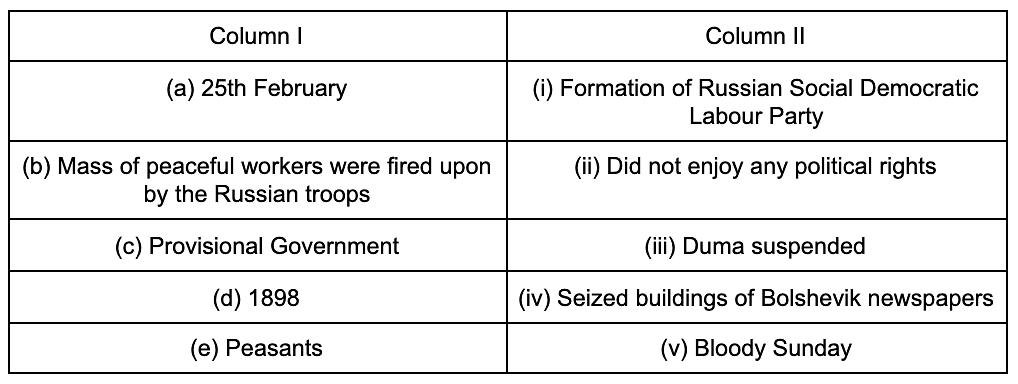Test: Socialism in Europe & the Russian Revolution (Term II)- 2 - Class 9 MCQ
15 Questions MCQ Test - Test: Socialism in Europe & the Russian Revolution (Term II)- 2
State whether True or False:
Lenin in his ‘April Theses’ demanded that the land should be under the complete power of the Monarch.
The Radicals wanted a nation in which the government was based on the _________of a country’s population.
| 1 Crore+ students have signed up on EduRev. Have you? Download the App |
Match the following:


The Bolsheviks did not gain majority support in the November 1917 elections.
Liberals opposed the uncontrolled power of dynastic rulers.
________________ built the cooperative called New Harmony.
In the questions given below, there are two statements marked as Assertion (A) and Reason (R). Read the statements and chose the correct option :
Assertion (A): Socialists were against Private Property, and saw it as the root of all social ills of the time.
Reason (R): The Propertied were concerned only with personal gain and not with the welfare of those who made the property productive.
A mass of peaceful workers were fired upon by the Russian troops when they went to the Winter Palace to present a petition to the Tsar. This incident occurred on Sunday 22nd January, 1905.
Consider the following statements regarding Karl Marx:
(1) He argued that the Industrial Society was ‘Capitalist’.
(2) That Capitalists owned the capital invested in factories, and the profit of capitalists was produced by workers.
(3) Workers had to overthrow capitalism and the rule of Private Properties.
Choose the correct option from the following:
Consider the following statements regarding ‘Liberals’.
(1) They wanted a nation that tolerated all religions.
(2) They wanted a nation in which the Government was based on the majority of a country's population.
(3) They also opposed the uncontrolled power of Dynastic Rulers.
Choose the right option from the following: Choose the correct option from the following:
The major cause of the February Revolution was __________________.
Answer the following in one word/one sentence:
What theory/ideas lays emphasis on restructuring the society?
Assertion (A): The Russian Social Democratic Workers Party had to operate as an illegal organization.
Reason (R): All political parties were illegal in Russia before 1914.
Assertion (A): Production increased rapidly due to Stalin’s Collectivization Programme.
Reason (R): There was bad harvest during 1930- 1933.
Answer the following in one word/one sentence:
What title was given to the Russian ruler?

















